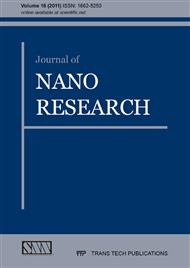p.83
p.89
p.97
p.105
p.113
p.119
p.131
p.141
p.153
New Approach to Ammonia Synthesis by Catalysis in Magnetic Field
Abstract:
Ammonia production is a capital-intensive industry as it requires high temperature (400-500oC) and also high pressure (150-300 bar) for its daily operations. An earnest effort was made to synthese ammonia gas using an in-house designed microreactor. The production of ammonia was carried out in a magnetic field reaction zone, with the reaction temperature of 30°C - 280°C and ambient operation pressure. Mn0.8Zn0.2Fe2O4 nanoparticles, synthesized using the sol gel method, were used as the catalyst for the ammonia synthesis. XRD confirmed the single phase ferrites and FESEM images revealed nanofibre-like morphology when sintered at 700oC in argon gas. Electron diffraction was performed using HRTEM and obtained diffraction patterns confirmed the crystal structure of the catalyst. By using the Kjeldahl method it was found that the reaction carried out in 1 Tesla magnetic field gave approximately 46% ammonia yield. The proposed new method could be appealing for ammonia manufacturers due to highly economical implication which may offer urea producers a potential contender in the competitive market place.
Info:
Periodical:
Pages:
119-130
Citation:
Online since:
January 2012
Keywords:
Permissions:
Share:
Citation:


